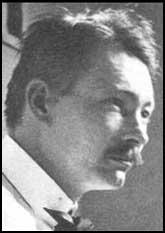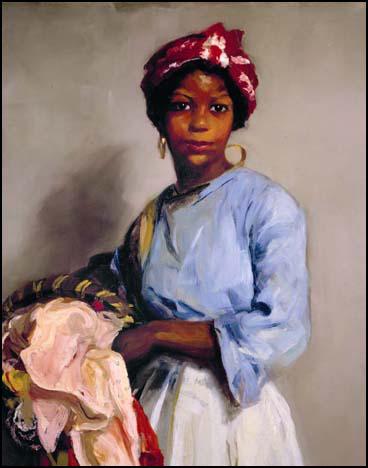Robert Henri

Robert Henri was born in Cincinnati, Ohio on 24th June, 1865. He studied art at the Pennsylvania Academy and at the Ecole des Beaux Arts in Paris. After returning to Philadelphia in 1891 he taught at the Women's School of Design.
A strong admirer of the work of Thomas Eakins, Henri was an advocate of realism in art. He later recalled: "Thomas Eakins was a man of great character. He was a man of iron will and his will to paint and to carry out his life as he thought it should go. This he did. It cost him heavily but in his works we have the precious result of his independence, his generous heart and his big mind. Eakins was a deep student of life, and with a great love he studied humanity frankly. He was not afraid of what his study revealed to him. In the matter of ways and means of expression, the science of technique, he studied most profoundly, as only a great master would have the will to study. His vision was not touched by fashion. He struggled to apprehend the constructive force in nature and to employ in his works the principles found. His quality was honesty. Integrity is the word which seems best to fit him. Personally I consider him the greatest portrait painter America has produced."
Eventually Henri became the leader of a movement that Art Young described as the Ash Can School. Henri taught his students that the artist's work should be "a social force that creates a stir in the world". Henri also urged artists to use the "rich subject-matter provided by modern urban life". Artists influenced by Henri's ideas included John Sloan, George Bellows, George Luks, Denys Wortman, Rockwell Kent and Edward Hopper.
In 1898 Henri began teaching at the New York School of Art. After an exhibition in 1904 one art critic noted: "Mr. Henri always has shown a desire to paint the truth. The quality in a portrait painter is likely to react to his disadvantage. When society folk have their faces and figures preserved on canvas they have a strong desire to look pretty, and a man who seeks only to perpetuate the truth is likely to be out of favour with the moneyed ones."
One of his students, Stuart Davis, later explained: "He (Henri) would talk about the paintings we brought in for three of four hours, and in the process of talking about those pictures he would criticise them not from the standpoint of some pre-established norm of excellence, but in relation to his own ideas. He'd talk about his own interests while he was talking about the painting and in the way, since he had more experience, more purposeful experience with culture in general than the crew of youths who were there, his discussions were very educational affairs."
When the National Academy in 1907 failed to recognize the importance of Henri and his followers he mounted his own exhibition under the title, The Eight. Henri argued: "The revolutionary parties that break away from old institutions, from dead organizations are always headed by men with a vision of order, with men who realize that there must be a balance in life, so much of what is good for each man, so much to test the sinews of his soul, so much to stimulate his joy."

The work of the Ash Can School became more widely known after 1911 when John Sloan became art editor of the radical journal, The Masses. Although they were rarely paid, Sloan was able to use the work of Henri as well as the artists he had influenced such as Stuart Davis, George Bellows, Rockwell Kent, Boardman Robinson, Robert Minor, K. R. Chamberlain, and Maurice Becker.
In 1913 the ideas of Henri inspired the International Exhibition of Modern Art (the Armory Show) held in New York City. Held at the 69th Regiment Armory, the exhibition included over 1,300 works, including 430 from Europe. The exhibition, held between 17th February and 15th March, received around 250,000 visitors.
After leaving the New York School of Art Henri taught at the Ferrer Center (1911-18) and the Arts Students League (1915-28). Henri's book, The Art Spirit, published in 1923, had a tremendous influence on young artists throughout America and Europe.
Robert Henri died on 12th July 1929.
Primary Sources
(1) New York Press (4th December, 1904)
Mr. Henri always has shown a desire to paint the truth. The quality in a portrait painter is likely to react to his disadvantage. When society folk have their faces and figures preserved on canvas they have a strong desire to "look pretty," and a man who seeks only to perpetuate the truth is likely to be out of favour with the moneyed ones.
(2) Stuart Davis was one of Robert Henri's students at the New York School of Art.
He would talk about the paintings we brought in for three of four hours, and in the process of talking about those pictures he would criticise them not from the standpoint of some pre-established norm of excellence, but in relation to his own ideas. He'd talk about his own interests while he was talking about the painting and in the way, since he had more experience, more purposeful experience with culture in general than the crew of youths who were there, his discussions were very educational affairs.
(3) Robert Henri, open letter to the Art Students League (29th October, 1917)
Thomas Eakins was a man of great character. He was a man of iron will and his will to paint and to carry out his life as he thought it should go. This he did. It cost him heavily but in his works we have the precious result of his independence, his generous heart and his big mind. Eakins was a deep student of life, and with a great love he studied humanity frankly. He was not afraid of what his study revealed to him.
In the matter of ways and means of expression, the science of technique, he studied most profoundly, as only a great master would have the will to study. His vision was not touched by fashion. He struggled to apprehend the constructive force in nature and to employ in his works the principles found. His quality was honesty. "Integrity" is the word which seems best to fit him. Personally I consider him the greatest portrait painter America has produced.
(4) Robert Henri, My People, The Craftsman: Volume 27 (February, 1917)
It is disorder in the mind of man that produces chaos of the kind that brings about such a war as we are today overwhelmed with. it is the failure to see the various phases of life in their ultimate relation that brings about militarism, slavery, the longing of one nation to conquer another, the willingness to destroy for selfish, inhuman purposes.
The revolutionary parties that break away from old institutions, from dead organizations are always headed by men with a vision of order, with men who realize that there must be a balance in life, so much of what is good for each man, so much to test the sinews of his soul, so much to stimulate his joy.

